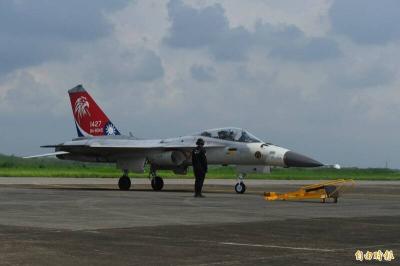The US is drawing up contingency plans for military deployments in Japan and the Philippines in case of a Taiwan emergency, Japan’s Kyodo news agency reported.
They would be incorporated in a first joint operation plan to be formulated in December, Kyodo reported late on Sunday, citing sources familiar with Japan-US relations.
A US Marine Corps regiment that possesses High Mobility Artillery Rocket Systems — a light multiple rocket launcher — would be deployed along the Nansei Island chain stretching from Kyushu to Yonaguni near Taiwan, Kyodo said.

Photo courtesy of the Ministry of National Defense
According to US military guidelines for dispatching marines in small formations to several locations, if a Taiwan contingency becomes imminent, temporary bases would be set up on inhabited islands, the report added.
Japan’s military is expected to mainly provide logistical support for the US marine unit, including supplying fuel and ammunition, it said.
The US Army would also deploy Multi-Domain Task Force long-range fire units in the Philippines, Kyodo said.
The defense ministries of Japan and the Philippines were not immediately available for comment. The US embassy in Manila declined to comment.
Asked about the report yesterday, the Chinese Ministry of Foreign Affairs said that Taiwan is an “inalienable part of China’s territory.”
“China firmly opposes relevant countries using the Taiwan issue as an excuse to strengthen regional military deployment, provoke tension and confrontation, and damage regional peace and stability,” Chinese Ministry of Foreign Affairs spokeswoman Mao Ning (毛寧) said.
China is building up its military capacity while ramping up pressure on Taiwan. Meanwhile, Washington has been strengthening alliances in the region and infuriating Beijing with regular deployments of ships and fighter jets in the Taiwan Strait and the South China Sea.
In other developments, Taiwan yesterday said it had detected a Chinese balloon over waters northwest of the nation, the first such sighting since April.
China regularly deploys fighter jets, drones and warships around Taiwan, and occasionally balloons, as it keeps up military pressure. The latest balloon was spotted at 6:21pm on Sunday, about 111km northwest of Keelung at an altitude of 10,058m, the Ministry of National Defense said.
It entered Taiwan’s air defense identification zone and disappeared at 8:15pm, the ministry said.
Twelve Chinese military aircraft and seven warships were also detected around the nation in the 24 hours to 6am yesterday, it added.
The ministry releases daily data on China’s military presence around Taiwan.
In the run-up to the January presidential election, balloons crossed the sensitive waters separating Taiwan and China day and night, with some floating above the nation. Taipei has described the balloons as a form of “gray zone” harassment — a tactic that falls short of an act of war.
China has previously brushed off allegations that it sends balloons over Taiwan, accusing Taipei of trying to raise tensions.
Asked about the balloon yesterday, Mao told reporters: “First of all, Taiwan does not have a ‘defense ministry.’ Furthermore, the question you asked is not a diplomatic one.”
Balloons from China became a politically fraught topic early last year when the US shot down what it called a spy balloon. The huge balloon, which carried a large payload of electronics, flew over sensitive US military installations and prompted concerns Beijing was scooping up vital intelligence.
Beijing has said it was a civilian airship blown off-course.

LOW RISK: Most nations do not extradite people accused of political crimes, and the UN says extradition can only happen if the act is a crime in both countries, an official said China yesterday issued wanted notices for two Taiwanese influencers, accusing them of committing “separatist acts” by criticizing Beijing, amid broadening concerns over China’s state-directed transnational repression. The Quanzhou Public Security Bureau in a notice posted online said police are offering a reward of up to 25,000 yuan (US$3,523) for information that could contribute to the investigation or apprehension of pro-Taiwanese independence YouTuber Wen Tzu-yu (溫子渝),who is known as Pa Chiung (八炯) online, and rapper Chen Po-yuan (陳柏源). Wen and Chen are suspected of spreading content that supported secession from China, slandered Chinese policies that benefit Taiwanese and discrimination against Chinese spouses of

PROMOTION: Travelers who want a free stopover must book their flights with designated travel agents, such as Lion Travel, Holiday Tours, Cola Tour and Life Tours Air Canada yesterday said it is offering Taiwanese travelers who are headed to North America free stopovers if they transit though airports in Japan and South Korea. The promotion was launched in response to a potential rise in demand for flights to North America in June and July next year, when the US, Canada and Mexico are scheduled to jointly host the FIFA World Cup, Air Canada said. Air Canada offers services to 13 of the 16 host cities of the tournament’s soccer games, including Toronto and Vancouver; Mexico City, Guadalajara and Monterrey in Mexico; Atlanta, Georgia; Boston; Dallas; Houston;

The US approved the possible sale to Taiwan of fighter jet spare and repair parts for US$330 million, the Pentagon said late yesterday, marking the first such potential transaction since US President Donald Trump took office in January. "The proposed sale will improve the recipient's capability to meet current and future threats by maintaining the operational readiness of the recipient's fleet of F-16, C-130," and other aircraft, the Pentagon said in a statement. Trump previously said that Chinese President Xi Jinping (習近平) has told him he would not invade Taiwan while the Republican leader is in office. The announcement of the possible arms

ALIGNED THINKING: Taiwan and Japan have a mutual interest in trade, culture and engineering, and can work together for stability, Cho Jung-tai said Taiwan and Japan are two like-minded countries willing to work together to form a “safety barrier” in the Indo-Pacific region, Premier Cho Jung-tai (卓榮泰) yesterday said at the opening ceremony of the 35th Taiwan-Japan Modern Engineering and Technology Symposium in Taipei. Taiwan and Japan are close geographically and closer emotionally, he added. Citing the overflowing of a barrier lake in the Mataian River (馬太鞍溪) in September, Cho said the submersible water level sensors given by Japan during the disaster helped Taiwan monitor the lake’s water levels more accurately. Japan also provided a lot of vaccines early in the outbreak of the COVID-19 pandemic,